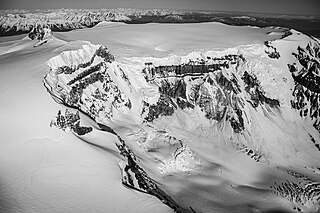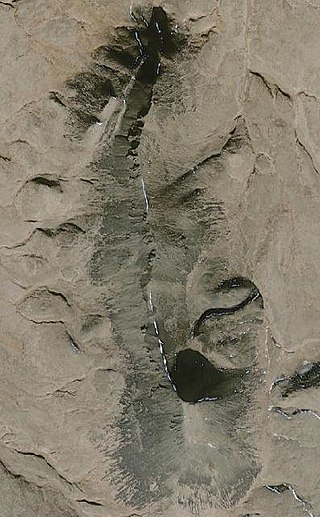
Mount Edziza, sometimes called Edziza Mountain or Edziza Peak, is a stratovolcano in Cassiar Land District of northwestern British Columbia, Canada. It is located on the Big Raven Plateau of the Tahltan Highland which extends along the western side of the Stikine Plateau. The mountain has an elevation of 2,786 metres, making it the highest volcano of the Mount Edziza volcanic complex. However, it had an elevation of at least 3,396 metres before its original summit was likely destroyed by a violent, climactic eruption in the geologic past. Mount Edziza contains several lava domes, cinder cones and lava fields on its flanks, as well as an ice cap that is characterized by several outlet glaciers stretching out to lower altitudes. All sides of the mountain are drained by tributaries of Mess Creek and Kakiddi Creek which are situated within the Stikine River watershed.

The Spectrum Range, formerly called the Spectrum Mountains and the Rainbow Mountains, is a subrange of the Tahltan Highland in the Stikine Country of northwestern British Columbia, 20 km west of the Stewart-Cassiar Highway, south of Mount Edziza and north of the Arctic Lake Plateau. The Spectrum Range falls within Mount Edziza Provincial Park. The range is lightly glaciated, as compared to the other ranges to the west. It is accessible only by foot or via helicopter; there are no roads to the range.

The Interior Mountains or Northern Interior Mountains are the semi-official names for an expansive collection of mountain ranges that comprises much of the northern half of the Canadian province of British Columbia and a large area of southern Yukon.

Tsekone Ridge, also called Tsekone Peak and Black Knight Cone, is an isolated ridge on the Big Raven Plateau of the Tahltan Highland in northwestern British Columbia, Canada. It is located southeast of Telegraph Creek at the north side of Mount Edziza Provincial Park between Eve Cone and Mount Edziza.

The Mount Edziza volcanic complex is a group of volcanoes and associated lava flows in northwestern British Columbia, Canada. Located on the Tahltan Highland, it is 40 kilometres southeast of Telegraph Creek and 85 kilometres southwest of Dease Lake. The complex encompasses a broad, steep-sided lava plateau that extends over 1,000 square kilometres. Its highest summit is 2,786 metres in elevation, making the MEVC the highest of four large complexes in an extensive north–south trending volcanic region. It is obscured by an ice cap characterized by several outlet glaciers that stretch out to lower altitudes.
Tadekho Hill is an isolated hill in the Northern Interior of British Columbia, Canada, located 64 km (40 mi) southwest of Tatogga and 10 km (6 mi) southwest of Kitsu Peak. It lies at the southwestern end of Mount Edziza Provincial Park.

The Mess Lake Lava Field is a volcanic field associated with the Mount Edziza volcanic complex of the Northern Cordilleran Volcanic Province in northwestern British Columbia, Canada. It lies northwest of the Spectrum Range on the Kitsu Plateau and consists of young basaltic lava flows and tephra. The source for the basaltic lava and tephra was three cinder cones, including Mess Lake Cone and The Ash Pit, which may be the youngest volcanic feature of the Mount Edziza volcanic complex.

The volcanic history of the Northern Cordilleran Volcanic Province presents a record of volcanic activity in northwestern British Columbia, central Yukon and the U.S. state of easternmost Alaska. The volcanic activity lies in the northern part of the Western Cordillera of the Pacific Northwest region of North America. Extensional cracking of the North American Plate in this part of North America has existed for millions of years. Continuation of this continental rifting has fed scores of volcanoes throughout the Northern Cordilleran Volcanic Province over at least the past 20 million years and occasionally continued into geologically recent times.
The Little Iskut River is a tributary of the Iskut River in the northwest part of the province of British Columbia, Canada, in Cassiar Land District. From its source at Little Ball Lake in Mount Edziza Provincial Park, the Little Iskut River flows about 45 km (28 mi), generally north to the vicinity of Mowdale Lake, then southeast and south to the Iskut River just below Cascade Falls. The Little Iskut River is part of the Stikine River drainage basin, as the Iskut River is a major tributary of the Stikine.

The Big Raven Formation is a stratigraphic unit of Holocene age in northwestern British Columbia, Canada. It is the youngest and least voluminous geological formation of the Mount Edziza volcanic complex (MEVC); it overlies at least six older formations of this volcanic complex. The main volcanic rocks of the Big Raven Formation are alkali basalts and hawaiites, although a small volume of trachyte comprises the Sheep Track Member. These rocks were deposited by volcanic eruptions in the last 12,000 years during the latest magmatic cycle of the MEVC. Alkali basalt and hawaiite are in the form of lava flows and small volcanic cones while trachyte of the Sheep Track Member is mainly in the form of volcanic ejecta which covers an area of about 40 square kilometres.
Artifact Creek is a tributary of Stewbomb Creek and part of the Stikine River watershed in northwest part of the province of British Columbia, Canada. It flows generally southeast for roughly 13 km (8.1 mi) to join Stewbomb Creek, which flows into the Little Iskut River.In turn the Little Iskut River flows to the Iskut River, the largest tributary of the Stikine River.
Gerlib Creek is a tributary of Bourgeaux Creek and part of the Stikine River watershed in northwest part of the province of British Columbia, Canada. It flows generally east and south for roughly 10.5 km (6.5 mi) to join the Bourgeaux Creek, a tributary of the Little Iskut River, which in turn is a tributary of the Iskut River, the largest tributary of the Stikine River.
Kitsu Creek is a tributary of Mess Creek and part of the Stikine River watershed in northwest part of the province of British Columbia, Canada. It flows generally northwest and north for roughly 22.5 km (14.0 mi) to join Mess Creek, a tributary of the Stikine River.
Nagha Creek is a tributary of Kitsu Creek and part of the Stikine River watershed in northwest part of the province of British Columbia, Canada. It flows generally northwest and north for roughly 15 km (9.3 mi) to join Kitsu Creek, a tributary of Mess Creek, which in turn is a tributary of the Stikine River.
Tadekho Creek is a tributary of Mess Creek and part of the Stikine River watershed in northwest part of the province of British Columbia, Canada. It flows generally northwest for roughly 18 km (11 mi) to join Mess Creek just north of Mess Lake.
Sorcery Creek is a tributary of Kakiddi Creek and part of the Stikine River watershed in northwest part of the province of British Columbia, Canada. From high peaks just south of Mount Edziza it flows generally east for roughly 13 km (8.1 mi) to empty into Kakiddi Lake, an expansion of Kakiddi Creek, a tributary of the Klastline River, which in turn is a tributary of the Stikine River.
Shaman Creek is a tributary of Kakiddi Lake, the source of Kakiddi Creek, and part of the Stikine River watershed in northwest part of the province of British Columbia, Canada. From its source in the glaciers south of Mount Edziza it flows generally east for roughly 20 km (12 mi) to empty into Kakiddi Lake, an expansion of Kakiddi Creek, a tributary of the Klastline River, which in turn is a tributary of the Stikine River.
Chakima Creek is a tributary of Shaman Creek and part of the Stikine River watershed in northwest part of the province of British Columbia, Canada. From its source in the mountains south of Mount Edziza, near Cartoona Peak and Tadeda Peak, it flows generally east for roughly 19 km (12 mi) to empty into Shaman Creek, which flows to Kakiddi Creek, a tributary of the Klastline River, which in turn is a tributary of the Stikine River.
Ball Creek is a tributary of the Iskut River and part of the Stikine River watershed in northwest part of the province of British Columbia, Canada. From its source in the mountains south of Mount Edziza, near Yeda Peak, it flows generally southeast and east for roughly 41 km (25 mi) to empty into the Iskut River, the largest tributary of the Stikine River.
More Creek is a tributary of the Iskut River and part of the Stikine River watershed in northwest part of the province of British Columbia, Canada. From its source near Yeda Peak in the Spectrum Range south of Mount Edziza, it flows generally south and east for roughly 65 km (40 mi) to empty into the Iskut River, the largest tributary of the Stikine River.








